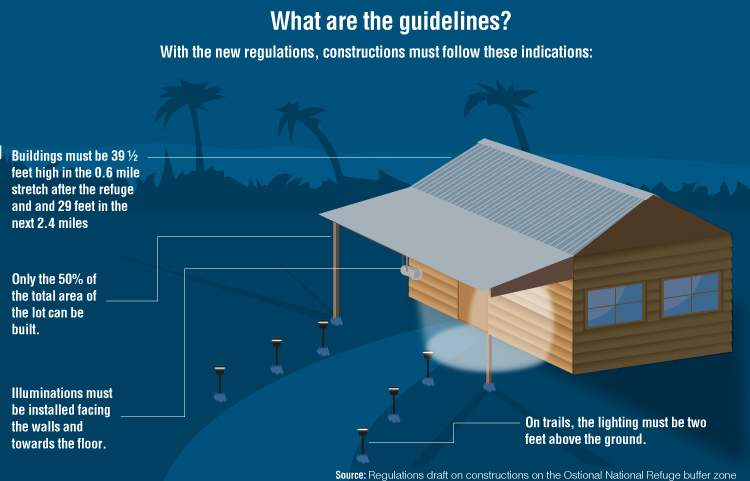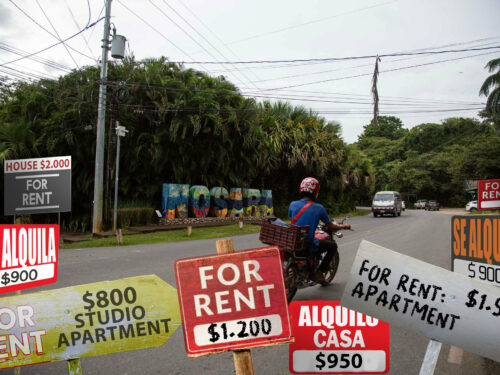
The official newspaper La Gaceta published on December 19th the new building regulations for Nosara . It’s the third version of temporary bylaws designed to protect the buffer zone around Ostional National Wildlife Refuge.
After nearly seven months of work, this is the last time the bylaws are open for feedback before the City publishes them definitively in the official newspaper. The community have 10 working days to do it.
The proposal, presented by the Nosara Civic Association (NCA) in April 2019, seeks to provide a “cushion” against human impact in the protected area while the City of Nicoya drafts a zoning plan.
The project was created to protect wildlife in the refuge from noise and building lights that can disorient turtles and other species.
“A good portion of the regulations were based on the sustainable development proposal from the Las Baulas National Marine Park and the Camaronal Wildlife Refuge,” said Francisco Jiménez, representative for the ACN, in May.
The turning point for the new bylaws is the protection of the environment. In reality, social development and environmental protection shouldn’t be seperate, says Karen Chacón, a researcher for think tank State of the Nation.
“It’s a myth to think that you either protect the environment or create economic development. That’s because we haven’t provided development options for coastal communities,” she said.
Doubts
Nosara’s La Esperanza Sur development association (Adiles) and the Nosara development association (ADIN) have criticized the plan, claiming they weren’t provided with enough information.
Adiles president Silvia Carrillo said “the authorities haven’t explained the details to us, nor how this will affect us, so we can’t take a position for or against it.”
Ruiz, from city hall, said they have held a lot of meetings to inform people.
“It was important to make this a participative process. That’s why we changed it so much,” he said.
According to Ruiz, over the last four months the city has held at least four acti- vities at different spots in Nosara to discuss the issue. Among the places visited are Santa Marta, downtown Nosara, and La Esperanza. Only 10 people attended the last meeting in La Esperanza.
The Voice of Guanacaste asked the Director of Nicoya’s construction over members of the two organizations and other residents of Nosara what their biggest doubs are about the new, temporary rules.
The responses are based on interviews with Ruiz, the NCA project coordinator, a sustainability expert and official documents about the project. These are most of the questions:
What were the main changes to the current draft?
The previous version put a limit on the division of lots on private property. Now, property owners can separate them regardless of the impact zone they have the land, but on each divided lot they can only build on 50% of the land.
They also removed recommendations about native plants and construction of fences and walls, and increased the maximum allowed height for new buildings. Now, buildings can’t be taller than 29 feet in the direct impact zone (⅔ of a mile after the refuge) and 39 ½ feet in the indirect impact zone (2.5 miles after the direct impact zone ends.)
Refuge managers recommend seeing a turtle arrival with guides certified by them.
What stays the same is the garages or pools still can’t be built in green zones, the obligation to have a wastewater treatment system, and rules on installing new lighting are also unchanged. See Chart.
How will the new rules affect buildings already built in Nosara?
They won’t. The bylaws only apply to new buildings, remodeling, expansions, repairs and/or demolition of existing buildings.
For example, if you want to change the lighting system on your property or add new lighting systems, you must install them facing the walls and ground. On trails, lighting can be a maximum of two feet above the ground.

Source: Regulations draft on constructions on the Ostional National Refuge buffer zone
Who is behind these regulations?
The Nosara Civic Association proposed the new rules in April 2019, following recommendations of the National System of Conservation Areas (Sinac), according to NCA project coordinator Francisco Jiménez.
The city took on the responsibility of completing future changes and financing. Ruiz said the city budgeted $70,000 per year for this set of bylaws and the Nicoya zoning laws.
In fact, Nosara new bylaws will be temporary and be in effect until the city publishes Nicoya’s zoning plan.
Why are they doing it now and not before?
The Nosara Civic Association explains on their website that they proposed the bylaws when they saw the area’s economic growth combined with its lack of construc- tion rules. It’s also been mentioned in multiple interviews with members of the asso- ciation.
Between 2010 and 2016, construction in Nosara has tripled, according to data from the association of engineers and architects and analyzed by The Voice. In 2010, some 33,700 square feet of construction were approved versus almost 100,000 square feet in 2016.
“The initiative has been taken up until now because constructions in Nosara are increasing and there are still no zoning laws. It was urgent,” said Jiménez from the NCA.
How do the bylaws help Nosara?
In order to answer this question, we turned to the Urban Sustainability Center (CPSU), an NGO totally independent of Nosara and with five years of experience in improving quality of life in cities.
Jessie Vega, climate action coordinator for CPSU, said that communities like Nosara depend entirely on natural resources to attract tourism.
“If building isn’t regulated, we are going to lose the natural capital that is the economic base for Nosara,” she said.
“It provides jobs for hundreds of people and when the ecosystem is lost, the economy, food and water for the region are also lost.”
Vega also says the regulations will help the City of Nicoya and Costa Rica fulfill its goals of fighting climate change.
“Costa Rica has big goals for biological diversity and climate action. Having green spaces in cities helps control climate and absorbs carbon, which helps reduce emissions in the country,” she said.
The City of Nicoya is taking part in the national “Carbon Neutral” Neutralidad, program by taking stock of its emissions in order to find ways to reduce its carbon footprint.
“With measures like the new set of bylaws, you can help cushion the loss of biological diversity and prevent the canton from emitting more carbon,” she said.
How can you play a bigger role?
Ruiz, the engineer, stressed the importance of citizen participation in this project. In addition to the next publication in La Gaceta, the city will open an email to hear feedback and doubts about the new regulations. The email is: [email protected]







Comments